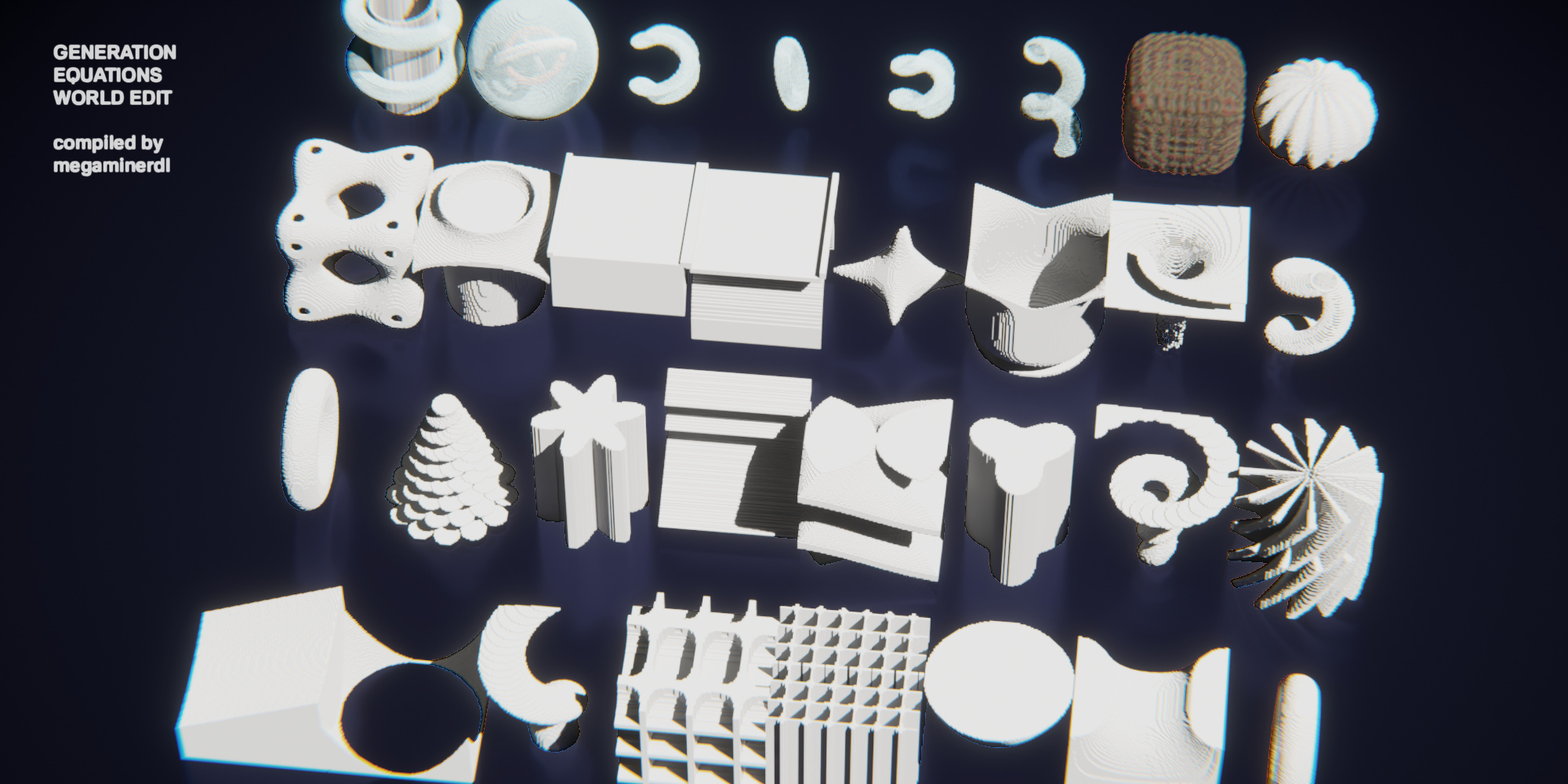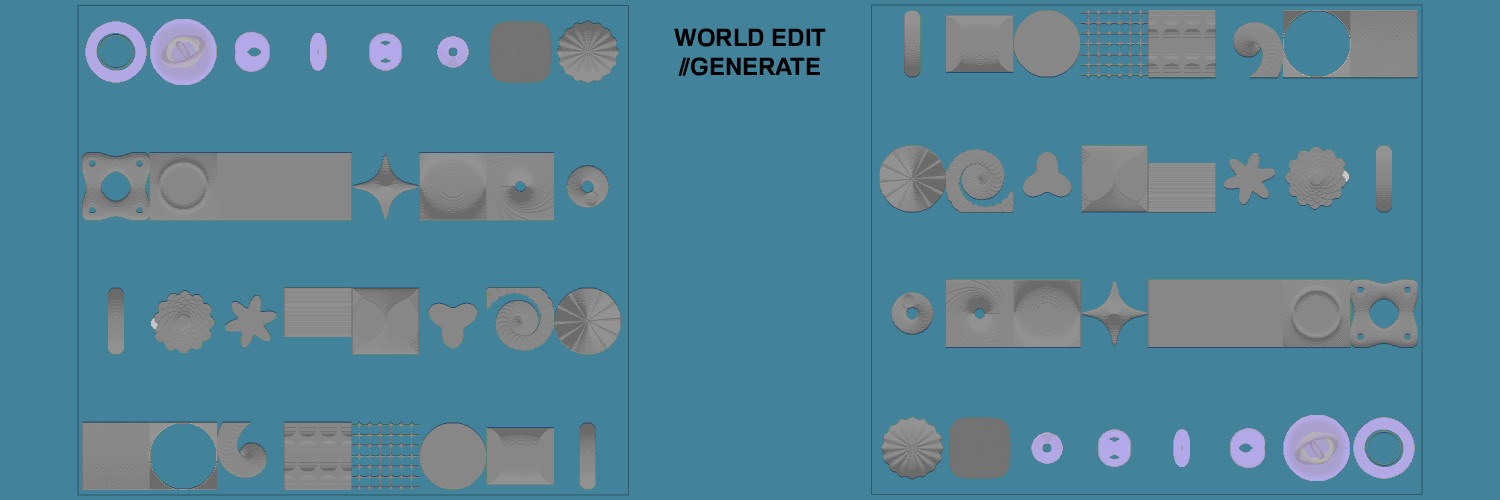
World Edit’s shape //generation ft. ChatGPT [Math formulas how-to & list]
[UPDATED] Shapes and colors: a guide. I’m trying to understand generation. Here are my notes!
3D parametric geometry
World Edit’s //g (//gen or //generate) command creates blocks using complex math equations within your selection. It’s powerful but not accessible – with the right shape, you could integrate it into your build to create donuts, trees, plants, terrain, ship hulls or decorations. I played around to try find useful examples!
Every shape can be combined or further modified with masking, stacking, rotation, or other plugins. I generated all my shapes on the cover at 100x100x100 size each. (SELECTION SIZE MATTERS!)
I searched the web for examples and asked ChatGPT to explain and give more. Take a look, copy these examples or prompt your own AI! (The prompt I gave was “In Minecraft World Edit I can generate a shape using <example //g command>. How does it work? Can you generate equations if I describe a shape?)
The hollow command accepts extra tags: -r (raw coordinates), -c (center), -o (origin shift) or -h (hollow).
World Edit Wiki basic examples

Torus of major radius 0.75 and minor radius 0.25: //g stone (0.75-sqrt(x^2+y^2))^2+z^2 < 0.25^2
Gnarled hollow tree: //g -h oak_log (0.5+sin(atan2(x,z)*8)*0.2)*(sqrt(x*x+z*z)/0.5)^(-2)-1.2 < y
Rainbow Torus: //g white_wool data=(32+15/2/pi*atan2(x,y))%16; (0.75-sqrt(x^2+y^2))^2+z^2 < 0.25^2
Rainbow Egg: //g white_wool data=(32+y*16+1)%16; y^2/9+x^2/6*(1/(1-0.4*y))+z^2/6*(1/(1-0.4*y))<0.08
A heart: //g red_wool (z/2)^2+x^2+(5*y/4-sqrt(abs(x)))^2<0.6
Sine wave: //g -h glass sin(x*5)/2<y
Radial cosine wave: //g -h glass cos(sqrt(x^2+z^2)*5)/2<y
Circular hyperboloid: //g stone -(z^2/12)+(y^2/4)-(x^2/12)>-0.03Various shapes through AI prompting
PICTURED IN COVER IMAGE (towards the front)
Tapering spiral staircase: //g stone turns=4;phase=pi/44;A0=0.40;A1=0.0;r=0.18;t=y;th=2*pi*turns*t+phase;A=A0+(A1-A0)*t;x+=sin(th)*A;z+=cos(th)*A;return x*x+z*z<r*r
turns=4; → 4 full turns (revolutions) of the spiral
phase=pi/44; → phase shift (rotation offset)
A0=0.40; A1=0.0; → spiral radius from start to end (tapering spiral)
r=0.18; → radius of the "tube" (thickness of the spiral)
t=y; → parametric variable t tied to the y-coordinate (height)
th=2*pi*turns*t+phase; → theta (angle) as a function of t
A=A0+(A1-A0)*t; → interpolate radius from A0 to A1 based on t
x+=sin(th)*A; → X coordinate from sine (spiral around center)
z+=cos(th)*A; → Z coordinate from cosine
return x*x+z*z<r*r; → defines the shape's thickness (a tube)Flower shape: //g stone x^2 + z^2 < (0.6 + 0.2*sin(6*atan2(x,z)))^2
Sin number = number of petals e.g. sin(3Large stair triangles: //g stone y > ((x+0.25)%0.5 - 0.25)*2
Rotate by changing xyz: //g stone x > ((y+0.25)%0.5 + 0.25)*2Square double helix: //g stone (abs(cos(atan2(x,z) + y*1*pi)) * 1) > max(abs(x),abs(z))
More turns = e.g. y*4*piTree-like spiral ramp: //g stone turns=2;a=0.2; b=0.15;t=y; th=2*pi*turns*t;r=a*exp(b*th);x+=sin(th)*r;z+=cos(th)*r;return x*x+z*z<0.05;
turns → more spiral loops
b → tighter or looser shell
0.05 → thickness of the shell wallCorkscrew drill: //g stone abs((atan2(x,z) + y*8*pi) % (pi/6)) < 0.1 && sqrt(x^2+z^2) < 1
8*pi → change number of turns (e.g., 4*pi = 2 turns)
pi/6 → spacing between steps
0.1 → step thickness
1 → radius of the staircaseH shaped ridge: //g stone abs(x) < 1 && x^4 + (y * (1 - z^2))^2 < 0.5Filled bowl-like shape: //g stone x^2 + z^2 < yBackrooms repeating grid Version 1: //g stone fractal = sin(10*x)*cos(10*z); return abs(fractal) < 0.1
Backrooms repeating grid Version 2: //g stone abs(sin(5*y) * cos(3*x)) < 0.2
Change number*xyz to change grid size or directionTree-like golden spiral: //g stone a=0.3; phi=1.618; t=y; theta=2*pi*t; r=a*phi^(theta); x+=cos(theta)*r; z+=sin(theta)*r; return x*x+z*z<0.1Four corner spike: //g stone x^2 + z^2 < y + 3 && x^2 + z^2 > y + 2Terrain canyon slope: //g stone y < 3 * sin(x / 5)^2 + 3 * sin(z / 7)^1
Play with the ^2 and ^1Shapes and rotations from AntOfThy
PICTURED IN COVER IMAGE (towards the back)
Sphere: //g -h glass x^2+z^2+y^2 < 1
Cylinder: //g -c -h stone x^2+z^2<25^2
Horizontal torus: //g -c -h glass (37-sqrt(x^2+z^2))^2+y^2<8^2
Angled torus: //g -c -h glass rotate(x,z,-.5); rotate(x,y,.25); data=(y>-4?15:0); (37-sqrt(x^2+z^2))^2+y^2<8^2
Nested rotated rings:
//g -c -h diorite rotate(x,z,.4); rotate(x,y,1); (30-sqrt(x^2+z^2))^2+y^2<4^2
//g -c -h granite rotate(x,z,-.2); rotate(x,y,-.4); (22-sqrt(x^2+z^2))^2+y^2<3^2
//g -c -h andesite rotate(x,z,-1); rotate(x,y,1.3); (16-sqrt(x^2+z^2))^2+y^2<2^2

Advanced shapes from WesterosCraft
PICTURED IN COVER IMAGE (towards the middle-back)
Hollow 4D Cube: //g stone ((x^4+y^4+z^4-x*x-y*y-z*z)^2-0.2)^2 < 0.001
Tower Hanging Roof: //g stone ((x*x+y*y*y*5+z*z-2.3)*(x*x+z*z-0.5))^2 < 0.02
Bridge Arch: //g stone (y> -(x^2)+0.85)*(z*z<0.95)*(y<0.95)+(z*z>0.85)*(y>0.9)
Fancy Bridge: //g stone (((x^4-0.6+y)^2<0.05*x^2)+((x^2/5-y+0.75)^2<0.02))*(z*z*9<8)*(y*9<8)+(z*z*7>6)*(y*9>8)
Spike star sparkle: //g stone ((x^2+y^2+(z/9)^2-0.01)*((x/9)^2+y^2+z^2-0.01)*(x^2+(y/9)^2+z^2-0.01))^2 <9^-6
Vase: //g stone (((x*x-y^5+z*z-1))^2<0.005)+((x^2+z^2+(y+0.99)^2*1500-0.4)^2 <0.3)
Tornado: //g stone (((atan2(x,z)+(y-1)*20+1/(x*x+z*z))*(atan2(x,z)+6.2832+(y-1)*20+1/(x*x+z*z)))^2<2)
Hollow Spiral: //g stone (((x-0.4*sin(y*5))^2+(z-0.4*cos(y*5))^2-0.04))^2 <0.00007
Pumpkin: //g stone (((x^2+1.5*y^2+z^2-(0.7+0.05*cos(16*atan2(x,z)))))^2 <0.01)Mega-fancy-cube: //g white_stained_glass data=((y*y+x*x+z*z+0.2)*32%4+12); ((x^4+y^4+z^4-0.6+cos(32*atan2(x,z))/32+cos(32*atan2(y,z))/32+cos(32*atan2(x,y))/32))^2 <0.002
Longer Commands: (These only work with a plugin that allows longer chat input?)
Double Helix: //g white_wool data=((y+1)*8)*(x*x+z*z<0.2)+(x*x+z*z>0.2)*15; ((((x-(sin(y*5)/1.5))^2+(z-(cos(y*5)/1.5))^2)<0.04))
+((((x+(sin((y)*5)/1.5))^2+(z+(cos((y)*5)/1.5))^2)<0.04))
+(((y+1)%0.125<0.025)
*(((((sin(y*5)*sqrt(x^2+z^2)-x)^2)+((cos(y*5)*sqrt(x^2+z^2)-z)^2))<0.005)
+((((sin(y*5)*sqrt(x^2+z^2)+x)^2)+((cos(y*5)*sqrt(x^2+z^2)+z)^2))<0.005)))
*((x^2 + z^2) < 0.5 )Cylinder & Offset Cylinder:
//g -c -h glass x^2+z^2<8^2
//g -c -h glass x-=15; x^2+z^2<8^2
Oval & Offset Oval Cylinder:
//g -c -h glass x-=15; x^2+z^2<8^2
//g -c -h glass z/=1.5; x-=15; x^2+z^2<8^2
Twisting vine spirals: (Stacking the Double Helix fits in 46x60x46?)
//g -c -h glass rotate(x,z,pi*y/30); z/=1.5; x-=15; x^2+z^2<8^2
//g -c -h glass rotate(x,z,pi*y/30); z/=1.5; x+=15; x^2+z^2<8^2
Vertical & Angled Torus:
//g -c glass (22-sqrt(x^2+y^2))^2+z^2<6^2
//g -c 95:15 rotate(y,z,.3); (22-sqrt(x^2+y^2))^2+z^2<6^2
Twisted Mobius Shape:
//g -c glass rotate(x,z,pi*y/30); (22-sqrt(x^2+y^2))^2+z^2<6^2
//g -c 95:15 rotate(x,z,pi*y/30); z-=10; (22-sqrt(x^2+y^2))^2+z^2<6^2Generating multi-colored shapes
I honestly don’t know, but AI helped explain in detail the multi-colored “Mega-fancy-cube” from above:
//g white_stained_glass data=((y*y+x*x+z*z+0.2)*32%4+12); ((x^4+y^4+z^4-0.6+cos(32*atan2(x,z))/32+cos(32*atan2(y,z))/32+cos(32*atan2(x,y))/32))^2 <0.002The command defines a fancy, distorted cube-like shape using high-powered terms (x^4, etc.) and angular ripples. It generates stained glass blocks within that shape, colored based on distance from the center, using a modular pattern that cycles thru brown, green, red, black.
The command has two parts separated by the ;
Part 1: white_stained_glass data=((y*y+x*x+z*z+0.2)*32%4+12);This sets the main block followed by its data value: In Minecraft Java, stained glass uses block states, but in older versions or with WorldEdit, data values (0–15) are used to determine color. In this example:
(y*y + x*x + z*z) → Squared distance from the origin, r².
+ 0.2 → Small offset, likely to prevent a singularity or weird behavior at the origin.
* 32 → Scales the result, likely to get a wider range of values.
% 4 → Modulo 4, results will wrap every 4 steps in radius squared (produces a repeating pattern).
+ 12 → Adds 12, shifting the base data value.
| Data | Color |
| ---- | ----- |
| 12 | Brown |
| 13 | Green |
| 14 | Red |
| 15 | Black |Part 2: ((x^4 + y^4 + z^4 - 0.6 + cos(32*atan2(x,z))/32 + cos(32*atan2(y,z))/32 + cos(32*atan2(x,y))/32))^2 < 0.002This is the shape boundary condition — it defines where the blocks are placed. In this example:
Base Shape:
x^4 + y^4 + z^4 - 0.6 → This resembles a superquadric (like a cube with rounded edges), since `x^4 + y^4 + z^4 = constant` gives a cube-ish shape. Subtracting 0.6 reduces the size — shrinking the boundary.
Cosine Modulation (32-fold sinusoidal ripples):
cos(32 * atan2(x,z)) / 32 → this adds a high-frequency ripple or twist along the x-z plane.
cos(32 * atan2(y,z)) / 32 → ripple in y-z.
cos(32 * atan2(x,y)) / 32 → ripple in x-y.
Whole Expression Squared:
(... )^2 < 0.002 → The squaring turns the surface condition into a very tight bound — like a fuzzy skin around the shape. Only points very close to the shape's surface (after modulation) will satisfy the condition.Change up paramenters or prompt AI to generate a new color equation! The color changes work with many block groups that have data values (You’ll recognize them if you used number IDs in pre-1.13), including stone, glass, terracotta. I modified 1-2 parameters to get a multi colored torus donut:
//g oak_wood data=((y*y+x*x+z*z+0.2)*2%4+12); (0.75-sqrt(x^2+y^2))^2+z^2 < 0.25^2References and links
- Generation — WorldEdit 7.2 documentation (enginehub.org)
- Commands — WorldEdit 7.2 documentation (enginehub.org)
- Releases · parisolab/mathmod (github.com) (3D shape software)
- K3DSurf : 3d surface generator (sourceforge.net) (3D shape software)
- Math 21a: Multivariable Calculus Formula and Theorem Review (tommymacwilliam.com)
- https://www.youtube.com/@AntOfThy/videos
- https://forum.westeroscraft.com/threads/terra-school-commands.3204/
- https://pastebin.com/9J7veASq & https://pastebin.com/9XqgMKnn
Cool use of //g in practice (with full commands in description!): The Egg, Albany, USA by Puntertje
To make this building I've used two mathematical formulas in Worldedit //generate commands:
//g -h -c 35 rotate(x,z,-0.33); rotate(z,y,-0.15); data=(y>0?0:8); (y<0?1.9*x^2+4*y^2+(z>0?1.3*z^2:0.78*z^2):1.75*x^2+9*(y+5)^2+(z>0?1.15*z^2:0.7*z^2)) > 43^2
for the top, and
//g -h -c 251:8 y=y+61; rotate(x,z,1.25); x=x-3; b=0.2; t=1; (y<60?((1.1*y+1)*(t-b)/2+b)^2-0.5*x^2-z^2:0) >= 2
for the bottom part.
You can try to make this shape yourself with these commands by making a selection of about 90x60x90 blocks big and running the commands, have fun!
No comments yet.